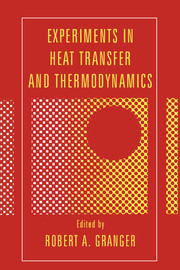Book contents
- Frontmatter
- Contents
- Preface
- Introduction
- Part I Experiments in heat transfer
- I.1 Conduction
- I.2 Convection
- Experiment 7 A forced convection heat-transfer experiment
- Experiment 8 Reynolds analogy for mass transfer
- Experiment 9 Natural-convection melting of a slab of ice
- Experiment 10 Forced-convection heat loss from 3D solids
- Experiment 11 Forced and free convective heat transfer of a laminar flow in a horizontal heated pipe
- Experiment 12 Measurement of convective heat-transfer coefficients on external surfaces
- Experiment 13 Measurement of local heat-transfer coefficient on the ice surface around isothermally cooled cylinders arranged in a line
- Experiment 14 Experiments of unsteady forced convection in ducts with timewise variation of inlet temperature
- Experiment 15 Measurement of heat and mass transfer from a body in air–water mist flow
- Experiment 16 Measurement of transient/steady heat-transfer coefficient with simultaneous photography of flow processes from beneath the heater surface
- I.3 Boiling
- I.4 Mixing, dispersion, and diffusion
- I.5 Radiation
- I.6 Heat pipes and exchangers
- Part II Experiments in thermodynamics
- Appendix 1 Experiments and demonstrations in thermodynamics
- Appendix 2 Experiments and demonstrations in heat transfer
- Appendix 3 Heat-transfer and thermodynamic films
- Index
Experiment 14 - Experiments of unsteady forced convection in ducts with timewise variation of inlet temperature
Published online by Cambridge University Press: 05 June 2012
- Frontmatter
- Contents
- Preface
- Introduction
- Part I Experiments in heat transfer
- I.1 Conduction
- I.2 Convection
- Experiment 7 A forced convection heat-transfer experiment
- Experiment 8 Reynolds analogy for mass transfer
- Experiment 9 Natural-convection melting of a slab of ice
- Experiment 10 Forced-convection heat loss from 3D solids
- Experiment 11 Forced and free convective heat transfer of a laminar flow in a horizontal heated pipe
- Experiment 12 Measurement of convective heat-transfer coefficients on external surfaces
- Experiment 13 Measurement of local heat-transfer coefficient on the ice surface around isothermally cooled cylinders arranged in a line
- Experiment 14 Experiments of unsteady forced convection in ducts with timewise variation of inlet temperature
- Experiment 15 Measurement of heat and mass transfer from a body in air–water mist flow
- Experiment 16 Measurement of transient/steady heat-transfer coefficient with simultaneous photography of flow processes from beneath the heater surface
- I.3 Boiling
- I.4 Mixing, dispersion, and diffusion
- I.5 Radiation
- I.6 Heat pipes and exchangers
- Part II Experiments in thermodynamics
- Appendix 1 Experiments and demonstrations in thermodynamics
- Appendix 2 Experiments and demonstrations in heat transfer
- Appendix 3 Heat-transfer and thermodynamic films
- Index
Summary
Principle
The temperature response of the unsteady inlet temperature varying with time is an essential parameter in the thermal design of the heat exchanger and other heat transport equipment. The temperature amplitude variation along the general passage decays exponentially and can usually be determined by experiment. This variation will affect the entire heat transport process within the heat exchanger and other heat-transport equipment.
Objective
The objective of this experiment is to determine the decay of the temperature oscillation along the channel for a timewise oscillation of inlet temperature. In practical applications, the heat transfer within the channel may be exposed to some planned or unplanned transients or start-ups and shutdowns during the operation. Thus, such a knowledge is critically necessary for those devices which never attain steady-state operation because of their nature of periodical operation in time.
Apparatus
The experimental apparatus consists of a rectangular duct with different sections of filter, calming, inlet, test, and convergence. The geometry of the test section is a rectangular duct with a cross section of 254 × 25.4 mm2 (10 × 1 in.2). The instrumentation includes a wave generator, a power supply, a heater, an inclined manometer, voltmeters, thermocouples, an orifice plate, and a fan, as shown in Fig. 14.1.
Air flows from the calming section to the inlet section (2770 mm in length) wherein the velocity becomes fully developed.
- Type
- Chapter
- Information
- Experiments in Heat Transfer and Thermodynamics , pp. 88 - 98Publisher: Cambridge University PressPrint publication year: 1994



